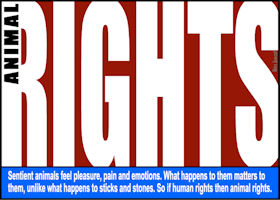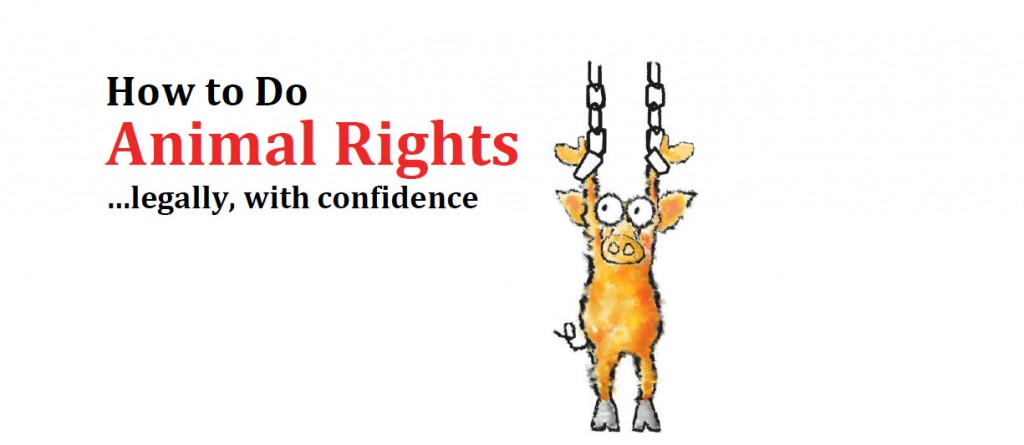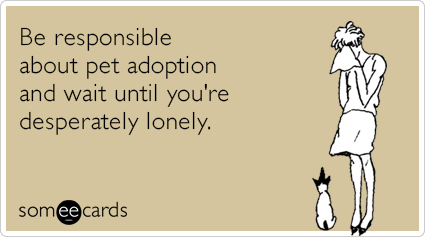“It is man's sympathy with all creatures that first makes him truly a man.”– Albert Schweitzer
TOPICS INCLUDE:
- animal abuse
- animal cruelty
- animal abuse facts
- animal testing facts
- animal abuse statistics
- animal cruelty laws
- animal cruelty facts
- animal charities
- animal testing pros and cons
- animal testing articles
- defenders of animal rights
- animal abuse stories
- stop animal abuse
- facts about animal abuse
- report animal abuse
- why do people abuse animals
- much more…
Animal rights are benefits people give to animals.
Benefits include the right of protection from human use and abuse and rights can take moral, legal and practical forms.
People who support animal rights believe that animals are not ours to use as we wish, for whatever purpose, be it for food, clothing, experimentation or entertainment.
Animal rights supporters also believe that we should consider the best interests of animals regardless of whatever value the animals may have for us.
“To spread the concept [of animal rights] beyond our species is to jeopardize our dignity as moral beings, who live in judgement of one another and of themselves.” Roger Scruton. Animal Rights. City Journal. 2000.
Alternatively:
“…animal rights must not only be an idea but a social movement for the liberation of the world's most oppressed beings, both in terms of numbers and in the severity of their pain.” Steven Best. Essay: Animal Rights and the New Enlightenment.
But what are animal rights specifically, how do animal rights compare with human rights, and are rights a remedy for all moral problems?
How to Do Animal Rights…Legally, With Confidence (186 pages), is intended to show anyone quickly and concisely how to work for animal rights as a practical legal activity, and to inform you about animal-human problems and ethics so that you can defend your actions rationally and confidently.
DEFINITION of Animal Welfare from the Saunders Comprehensive Veterinary Dictionary:
- Understand activist methods that will further your activism.
- Discover practical animal rights activities you can do.
- Know what animal rights means and how it differs from other outlooks.
- Be aware of potential conflict with the law and how you can handle it.
- Find inspiration from biographies of a selection of animal rights activists.
- Recognize how humanity is devastating animal life globally.
- Gasp at the numbers of animals humans kill every year.
- Add topics to your armory the well rounded animal activist should know.
So let's defend life and promote a humane society.
Instant Access (no requirements or opt-in necessary):
You have permission to disseminate this document globally, by electronic means or in print, to advance animal rights.
You are welcome to copy the text of this document for your personal non-profit use,
online or in print (for web site / blog, newsletter, magazine, etc.), to promote animal rights.
From Inside…
Universal Declaration on Animal Welfare
PREAMBLE The Manila Conference on Animal Welfare recognizes: That animal welfare is an issue worth consideration by governments. That the promotion of animal welfare requires collective action and all stakeholders and affected parties must be involved.
That work on animal welfare is a continuous process.
A PROPOSAL FOR A DECLARATION ON ANIMAL WELFARE ARISING FROM THE MANILA CONFERENCE:
RECOGNIZING that animals are living, sentient beings and therefore deserve due consideration and respect;
RECOGNIZING that animal welfare includes animal health;
RECOGNIZING that humans share this planet with other species and other forms of life and that all forms of life co-exist within an interdependent ecosystem;
RECOGNIZING that, although there are significant social, economic, religious and cultural differences between human societies, each should care for and treat animals in a humane and sustainable manner;
AGREEING that the term nation includes peoples, civil society and the state;
ACKNOWLEDGING that many nations already have a system of legal protection for animals, both domestic and wild;
SEEKING to ensure the continued effectiveness of these systems and the development of better and more comprehensive animal welfare provisions;
ACKNOWLEDGING that the humane use of animals can have major benefits for humans;
AWARE that the “five freedoms (freedom from hunger, thirst and malnutrition; freedom from fear and distress; freedom from physical and thermal discomfort; freedom from pain, injury and disease; and freedom to express normal patterns of behavior)” and the “three Rs (reduction in numbers of animals, refinement of experimental methods and replacement of animals with nonanimal techniques)” provide valuable guidance for the use of animals;
RECOGNIZING that the provisions contained in this declaration do not affect the rights of any nation;
PRINCIPLES OF THE DECLARATION:
1. The welfare of animals shall be a common objective for all nations;
2. The standards of animal welfare attained by each nation shall be promoted, recognized and observed by improved measures, nationally and internationally, respecting social and economic considerations and religious and cultural traditions;
3. All appropriate steps shall be taken by nations to prevent cruelty to animals and to reduce their suffering;
4. Appropriate standards on the welfare of animals be further developed and elaborated such as, but not limited to, those governing the use and management of farm animals, companion animals, animals in scientific research, draft (used to pull loads) animals, wildlife animals and animals in recreation.
The Five Freedoms:
● Freedom from Hunger and Thirst – by ready access to fresh water and a diet to maintain full health and vigor.
● Freedom from Discomfort – by providing an appropriate environment including shelter and a comfortable resting area.
● Freedom from Pain, Injury or Disease – by prevention or rapid diagnosis and treatment.
● Freedom to Express Normal Behavior – by providing sufficient space, proper facilities and company of the animal's own kind
● Freedom from Fear and Distress – by ensuring conditions and treatment which avoid mental suffering.
![]()
Appropriate policies, legislation and standards on the welfare of…companion animals…can be seen by going here.
The Veterinary Bulletin on this topic can be found here.
In Summary:
On Hopelessness
…or feelings of pointless inadequacy and ineptitude:
Animal suffering caused by humanity is so vast that it is easy to feel dismayed at its scale and one‟s seemingly ineffectual struggles to relieve it. How can we tackle feelings of pointless inadequacy and ineptitude we may sometimes feel? We have to arm ourselves with the right attitudes.
Get How To Do Animal Rights for help with your armor:






